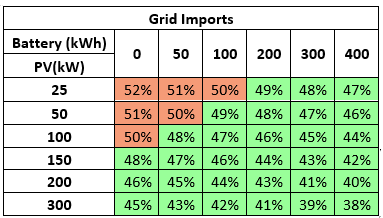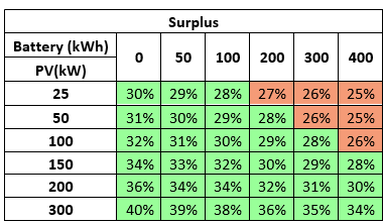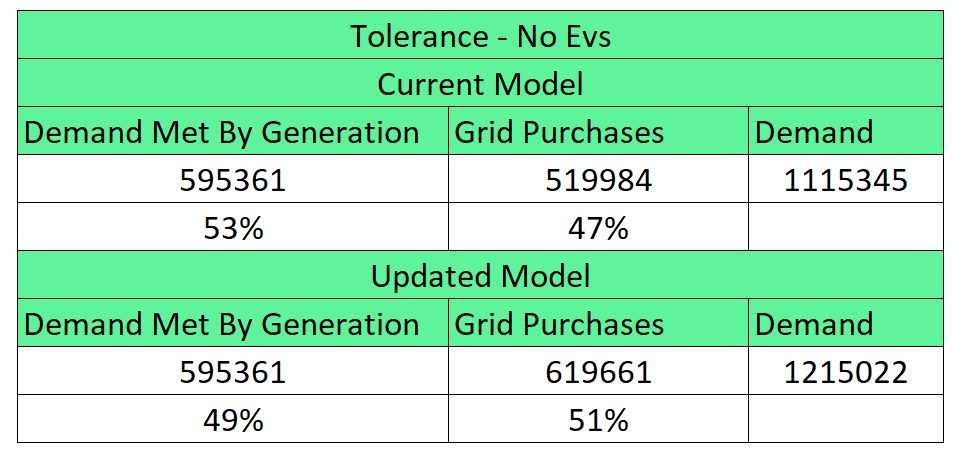The research of alternatives for mitigation of the increase of imports caused by the increase of demand due to EV adoption, was focused on the already used energy sources. These sources in Findhorn Ecovillage case, are wind and solar PVs. On this section, are displayed the results and comparison of the two sources in terms of which of the two achieved better results for the KPI. For both sources, there was examined the increase for the same capacity, in order to have a common criterion to measure their efficiency for same quantities. Therefore, for both wind and PV capacities there were used the addition of 75 kW, 225kW that were defined by the fixed nominal power output of the wind turbines. Comparisons have been made using the 100% controlled EV demand profile, as these consist the worst case scenario for demand increase and would give more discernible results.
The tables below show percentages for grid imports for the various combinations of PV and storage capacity increase. PV capacity was increased from the already installed capacity of 25kW up to 300kW and the REDOX flow batteries from 0kWh to 400kWh, including also the results for the already but inactive battery of 50kWh.
Without additional generation for these periods, the Ecovillage would have to rely on imports to meet demand. Therefore, the objective of the following analysis was to investigate additional generation capacity to minimise these periods of deficit. Comparing figures above, there is a notable difference in demand not met by generation, resulting in the summer week requiring a greater need for imported electricity. This was apparent throughout the summer months, which was expected as primary electricity generation resource is wind that is abundant at winter but sparse during summer.
On the imports table, red coloured cells represent combinations that do not address to the KPI criterion, which is to keep imports below 50%. Therefore, they are rejected. The green coloured cells represent combinations that are acceptable. From that table, it is obvious that for the current PV capacity of 25kW the storage would need to be increased above 200kWh, which is quite significant. On the other hand, the increase of PV capacity seems to be more effective, as for no storage it allows Findhorn to be net exporter, for installed capacities above 150 kW. The utilisation of the purchased battery, is presented on the second column of the table. For the examined 100% adoption rate, imports remain under 50% by at least quadrupling the already existing PV capacity.
As regards the surplus, the increase of storage with no additional generation decreases it significantly and in order to maintain or even increase it would require significant amount of additional generation. The highest percentage as expected, is for the maximum PV capacity with no storage, as this would mean that all the non-used generated energy from the grid would not be stored but it would be available for sale.
Although achieving to keep imports below 50%, many of the combinations on the imports table are near 50%. This practically means that only a small increase on demand would suggest these solutions insufficient. Therefore, there should be set a tolerance that would limit the acceptable solutions space to these that are below that limit, in order to cover up possible future demand fluctuations.
As regards the surplus, the increase of storage with no additional generation decreases it significantly and in order to maintain or even increase it would require significant amount of additional generation. The highest percentage as expected, is for the maximum PV capacity with no storage, as this would mean that all the non-used generated energy from the grid would not be stored but it would be available for sale.
Although achieving to keep imports below 50%, many of the combinations on the imports table are near 50%. This practically means that only a small increase on demand would suggest these solutions insufficient. Therefore, there should be set a tolerance that would limit the acceptable solutions space to these that are below that limit, in order to cover up possible future demand fluctuations.
Applying a Tolerance
During the progression of the project, it became know to the team that Findhorn Ecovillage is no longer a net exporter of electricity, but now relies on the grid with around 51% grid imports to 49% demand met by local generation. To account for this within our modelling, we applied a tolerance to the above results to ensure our recommended capacity addition would once again allow the Ecovillage to be a net exporter of electricity.
To calculate the demand increase this would correlate to, we assumed that the demand met by generation will be the same as our model as no new capacity has been installed, except the battery but that is not operational yet. This meant we could calculate the new grid purchases and demand based on the percentage value we were provided, with the results shown below.
To calculate the demand increase this would correlate to, we assumed that the demand met by generation will be the same as our model as no new capacity has been installed, except the battery but that is not operational yet. This meant we could calculate the new grid purchases and demand based on the percentage value we were provided, with the results shown below.
This demand increase in kWh was added to each PV addition, with the 25kW-50kWh battery selected as the our prior research showed this was the most effective, to provide the new demand for each case. With the demand met by local generation remaining constant, we could now calculate the updated results for each PV capacity addition investigated, which are shown below.
The results showed that 300kW solar PV addition would provide 53% demand met by local generation, the same as the model we used for the current demand. We applie this 3% tolerance from a 50-50 ratio to accommodate uncertainty in the calculations shown above, to result in the final suggestion of a 300kW solar PV farm addition and using the 25kW-50kWh REDOX battery.

UNIVERSITY OF STRATHCLYDE
Address:
16 Richmond St
Glasgow G1 1XQ
United Kingdom
Phone:
+ 44 141 552 4400
Address:
16 Richmond St
Glasgow G1 1XQ
United Kingdom
Phone:
+ 44 141 552 4400





